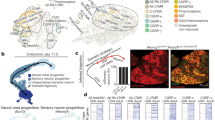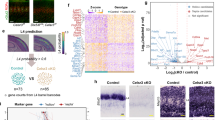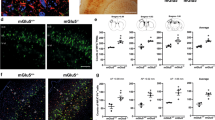Abstract
The somatosensory (SI) cortex of mice displays a patterned, nonuniform distribution of neurons in layer IV called the 'barrelfield' ( ref. 1). Thalamocortical afferents (TCAs) that terminate in layer IV are segregated such that each barrel, a readily visible cylindrical array of neurons surrounding a cell-sparse center, represents a distinct receptive field. TCA arbors are confined to the barrel hollow and synapse on barrel-wall neurons whose dendrites are oriented toward the center of the barrel2. Mice homozygous for the barrelless (brl) mutation, which occurred spontaneously in ICR stock at Université de Lausanne (Switzerland), fail to develop this patterned distribution of neurons, but still display normal topological organization of the SI cortex3. Despite the absence of barrels and the overlapping zones of TCA arborization, the size of individual whisker representations, as judged by 2-deoxyglucose uptake, is similar to that of wild-type mice. We identified adenylyl cyclase type I (Adcy1) as the gene disrupted in brl mutant mice by fine mapping of proximal chromosome 11, enzyme assay, mutation analysis and examination of mice homozygous for a targeted disruption of Adcy1. These results provide the first evidence for involvement of cAMP signalling pathways in pattern formation of the brain.
This is a preview of subscription content, access via your institution
Access options
Subscribe to this journal
Receive 12 print issues and online access
$209.00 per year
only $17.42 per issue
Buy this article
- Purchase on Springer Link
- Instant access to full article PDF
Prices may be subject to local taxes which are calculated during checkout




Similar content being viewed by others
References
Woolsey, T.A. & Van der Loos, H. The structural organization of layer IV in the somatosensory region of mouse cerebral cortex: The description of a cortical field composed of discrete cytoarchitectonic units. Brain Res. 17, 205–242 ( 1970).
Woolsey, T.A., Dierker, M.L. & Wann, F. Mouse SmI Cortex: Qualitative and quantitative classification of Golgi-impregnated Barrel neurons. Proc. Natl Acad. Sci. USA 72, 2165–2169 (1975).
Welker, E. et al. Modified tactile processing in somatosensory cortex of a new mutant mouse, barrelless. Science 271, 1864– 1867 (1996).
Copeland, N.G. et al. Genome Maps IV. Science 262, 67– 82 (1993).
Edelhoff, S., Villacres, E.C., Storm, D.R. & Disteche, C.M. Mapping of adenylate cyclase genes type I, II, III, IV, V, VI in mouse. Mamm. Genome 6, 111–113 ( 1995).
Xia, Z., Choi, E.J., Wang, F., Blazynski, C. & Storm, D.R. Type I Calmodulin-Sensitive Adenylate cyclase is neural specific. J. Neurochem. 60, 305– 311 (1993).
Wu, Z., Wong, S.T. & Storm, D.R. Modification of the Ca2+/Calmodulin sensitivity of the type I adenylyl cyclase by mutagenesis of its calmodulin binding domain. J. Biol. Chem. 268, 23766–23768 (1993).
Wu, Z.L. et al. Altered behavior and long-term potentiation in type I adenylate cyclase mutant mice. Proc. Natl Acad. Sci. USA 92, 220– 224 (1995).
Wayman, G.A., et al. Synergistic activation of the type I adenylyl cyclase by Ca2+ and Gs-coupled receptors in vivo. J. Biol. Chem. 269, 25400–25405 (1994).
Villacres, E.C. et al. Developmentally expressed Ca2+-sensitive adenylate cyclase activity is disrupted in the brains of type I adenylate cyclase mutant mice . J. Biol. Chem. 270, 14352– 14357 (1995).
Steinmeyer, K. et al. Inactivation of muscle chloride channel by transposon insertion in myotonic mice. Nature 354, 304–308 (1991).
Mitreiter, K. et al. Disruption of the murine p53 gene by insertion of an endogenous retrovirus-like element (ETn) in a cell line from radiation-induced osteosarcoma. Virology 200, 837–841 ( 1994).
Davis, R.L. Physiology and biochemistry of Drosophila learning mutants. Physiol. Rev. 76, 299–317 ( 1996).
Byrne, J.H. et al. Neural and molecular basis of nonassociative and associative learning in Aplysia . Ann. N. Y. Acad. Sci. 627, 124– 149 (1991).
Yovell, Y. & Abrams, W. Temporal asymmetry inactivation of Aplysia adenylyl cyclase by calcium and transmitter may explain temporal requirements of conditioning. Proc. Natl Acad. Sci. USA 89, 6526–6530 (1992).
Cases, O. et al. Aggressive behavior and altered amounts of brain serotonin and norepinephrine in mice lacking MAOA. Science 268, 1763– 1766 (1995).
Cases, O. et al. Lack of barrels in somatosensory cortex of Monoamine Oxidase A-deficient mice: role of a serotonin excess during the critical period. Neuron 16, 297–307 (1996).
Bennett-Clarke, C.A., Leslie, M.J., Lane, R.D. & Rhoades, R.W. Effect of serotonin depletion on vibrissa-related patterns of thalamic afferents in the rat's somatosensory cortex. J. Neurosci. 14, 7594 –7607 (1994).
Lebrand, C. et al. Transient uptake and storage of serotonin in developing thalamic neurons. Neuron 17, 823–835 ( 1996).
Bennett-Clarke, C.A., Leslie, M.J., Chiaia, N.L. & Rhoades, R.W. Serotonin 1B receptors in the developing somatosensory and visual cortices are located on thalamocortical axons. Proc. Natl Acad. Sci. USA 90, 153–157 ( 1993).
Bouhelal, R., Smounya, L. & Bockaert, J. 5-HT1B receptors are negatively coupled with adenylate cyclase in rat substania nigra. Eur. J. Pharmacol. 151, 189–196 (1988).
Rhoades, R.W., Bennett-Clark, C.A., Shi, M.-Y. & Mooney, R.D. Effects of 5-HT on thalamocortical synaptic transmission in the developing rat. J. Neurophysiol. 72, 2438–2450 (1994).
Mitrovic, N., Mohajeri, H. & Schachner, M. Effects of NMDA receptor blockade in the developing rat somatosensory cortex on the expression of the glia-derived extracellular matrix glycoprotein tenascin-C . Eur. J. Neurosci. 8, 1793– 1802 (1996).
Song, H-j., Ming, G-l . & Poo, M-m. cAMP-induced switching in turning direction of nerve growth cones. Nature 388, 275– 279 (1997).
Claudio, J.O., Malo, D. & Rouleau, G.A. The mouse neurofibromatosis type 2 gene is highly conserved. Genomics 21, 437–439 ( 1994).
Dietrich, W.F. et al. A comprehensive genetic map of mouse genome. Nature 380, 149–152 (1996).
Larin, Z., Monaco, A.P., Meier-Ewert, S. & Lehrach, H. Construction and characterization of yeast artificial chromosome libraries from the mouse genome . Methods Enzymol. 225, 623– 637 (1993).
Kusumi, K., Smith, J.S., Segre, J.A., Koos, D.S. & Lander, E.S. Construction of a large-insert yeast artificial chromosome library of the mouse genome. Mamm. Genome 4, 391–392 (1993).
Haldi, M.L. et al. A comprehensive large-insert yeast artificial chromosome library for physical mapping of the mouse genome. Mamm. Genome 7, 767–769 (1996).
Johnson, R.A. & Sutherland, E.W. Detergent-dispersed adenylate cyclase from rat brain. J. Biol. Chem. 248, 5114–51121 (1973).
Acknowledgements
We thank A. Blackadar, B. Cusack and K. Furue for technical assistance, and H. Lehrach and F.B. Palmer for support. This work has been supported by the Medical Research Council of Canada (grant MT-12941).
Author information
Authors and Affiliations
Corresponding author
Rights and permissions
About this article
Cite this article
Abdel-Majid, R., Leong, W., Schalkwyk, L. et al. Loss of adenylyl cyclase I activity disrupts patterning of mouse somatosensory cortex. Nat Genet 19, 289–291 (1998). https://doi.org/10.1038/980
Received:
Accepted:
Issue Date:
DOI: https://doi.org/10.1038/980
This article is cited by
-
Mutations in Eml1 lead to ectopic progenitors and neuronal heterotopia in mouse and human
Nature Neuroscience (2014)
-
Role of NMDA receptors in adult neurogenesis: an ontogenetic (re)view on activity-dependent development
Cellular and Molecular Life Sciences (2013)
-
Genetic analysis of posterior medial barrel subfield (PMBSF) size in somatosensory cortex (SI) in recombinant inbred strains of mice
BMC Neuroscience (2008)
-
Adenylyl cyclase type 8
AfCS-Nature Molecule Pages (2008)



